In this article, I will reveal 3 different ways to checkmate your opponent in just 5 moves. Some of these strategies are dubious, but nonetheless, a lot of beginner and intermediate players may fall for the traps.
Not all the time you will have the opportunity to checkmate your opponent in 5 moves. Sometimes you have to deviate from general opening principles just to set the trap for your opponent. However, It’s always recommended that you stick to general opening priniples. If you try to attack too early and prematurely, your pieces will get kicked back and you may end up with a bad position.
On the other hand, if your opponent is behind in development or has an unsafe king, then you may attack early by exploiting the weaknesses in the position.
With that said, here are 3 strategies to win chess in 5 moves:
How To Win Chess In 5 Moves
1. Caro-Kann 5 Move Checkmate
The Caro-kann defense is a solid opening that is difficult to crack even for grandmasters. So to think that there is actually a 5 move checkmate in the opening can be quite the shocker.
Indeed, white can take down the Caro-kann defense in just 5 moves, but you will have to deviate from the mainline in order to set the trap for black.
Here is how to win chess in 5 moves in the Caro-Kann Defense:
- Move your King’s pawn to e4
- Black plays 1…c6
- Move your queenside knight to c3
- Black plays 2…d5
- Bring out your queen to the e2 square
- Black plays 3…dxe4
- Recapture black’s pawn with the knight
- Black plays 4…Nd7
- Move your knight to the d6 square to deliver checkmate to the black king
White checkmates the black king in 5 moves
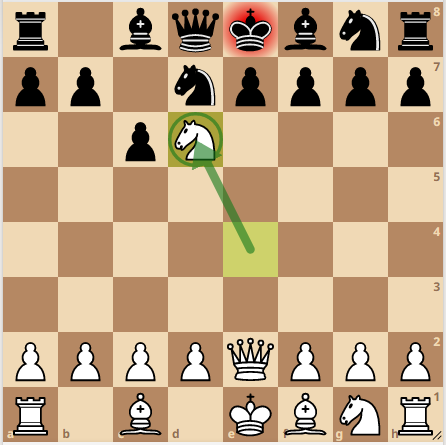
Let’s take a look at each move in detail.
Step 1: Move Your King’s Pawn To e4
Advance your pawn 2 squares forward in front of your king. The idea of pawn to e4 is to open lines for your long ranged pieces and to take control of key squares in the center. Black plays pawn to c6 with the idea of preparing pawn to d5. This is known as the Caro-kann defense which is a solid opening choice for black.
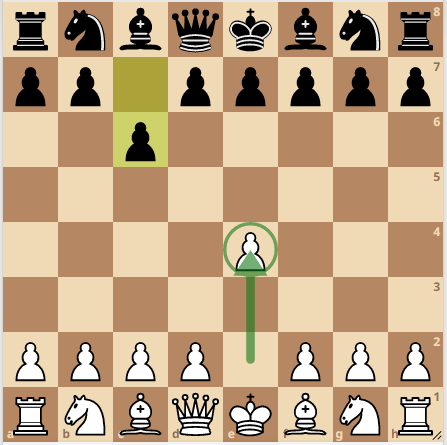
Step 2: Move your queenside knight to c3
Move your queenside knight from b1 to c3. The knight from c3 protects the e4 pawn and helps to control more squares in the center.
Black continues his plan of playing in the center with the move pawn to d5. In other lines of the Caro-kann defense, black would be threatening to win white’s pawn on e4. However, due to the knight’s placement on c3, white is in time to recapture on e4 in the event black plays dxe4.

Step 3: Bring out your queen to the e2 square
Usually, the queen is the last piece to move in the opening. But for tactical purposes, there is an exception. The Queen on e2 is aligning itself with the black king on the e-file. This is a tactical theme you should know which can lead to all sorts of nasty tricks in the position as you’ll see later.
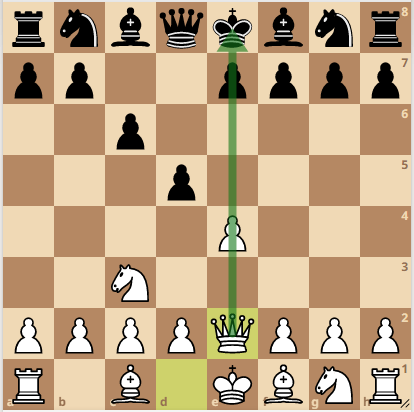
Queen e2 is a deep move. White understand black’s plan and is setting up a trap if black continues to play in the spirit of the caro-kann. White knows that Black is going to capture on e4 and develop his queenside knight to d7 to prepare knight to f6 (a typical strategy if you’ve ever played the caro-kann).
Black plays 3…dxe4, continuing his normal plan.
Step 4: Recapture black’s pawn with the knight
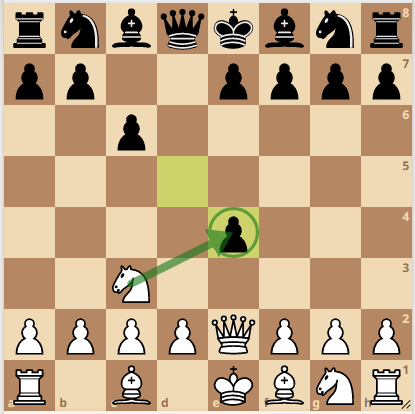
Here it’s important to recapture on e4 with the knight and not the queen. The knight on e4 is well centralized and is prepared to deliver checkmate on d6 if black plays 4…Nbd7
The best move for black is to actually play 4…Nf6 anyways, which goes against the strategy of the Caro-kann defense. This will double black’s pawn after 5.Nxf6 gxf6. But it’s better than getting checkmated of course.
4…Nbd7??

Black wants to prevent his pawns from doubling, but in doing so blunders checkmate. White now plays 5.Nd6 and checkmate the black king in just 5 moves.
Black’s lack of kingside development and not paying attention to the tactical theme in the position lead to his own demise. Black cannot capture the knight on d6 because the pawn on e7 is pinned due to the placement of white’s queen on the e-file which is eyeing the black king.
2. Dutch Defense 5 Move Checkmate
The dutch defense is a hyper-modern way of playing chess by controlling the center without occupying it with pieces. White can checkmate black in 5 moves in the dutch defense by exploiting the weak squares created after pawn to f5.
Here is how to checkmate in 5 moves in the Dutch Defense Opening:
- Move your queen’s pawn to d4
- Black plays 1…f5
- Move your dark squared bishop all the way to the g5 square
- Black plays 2…h6
- Retreat your bishop to h4
- Black plays 3…g5
- Sacrifice your bishop with pawn to e4
- If black plays 4…gxh4, deliver checkmate by moving your queen to h5
White checkmates the black king in 5 moves

Step 1: Move Your Queen’s Pawn To d4
Move your d-pawn 2 squares forward to open lines for your dark squared bishop. Pawn to d4 also helps to control the center of the board which is a general opening prinicple.
Black plays pawn to f5. This is known as the Dutch opening. Black plays in the hyper modern fashion by allowing white to occupy the center with his pieces. The drawback to playing f5 is that it somewhat weakens the squares around the black king.

Step 2: Move Your Dark-squared Bishop to the g5 square
Move your c1 bishop all the way to g5. This baits or provoke black into kicking away the bishop with the move pawn to h6.
However, after black plays 2…h6, Black is left with a lot of weak squares around his king. 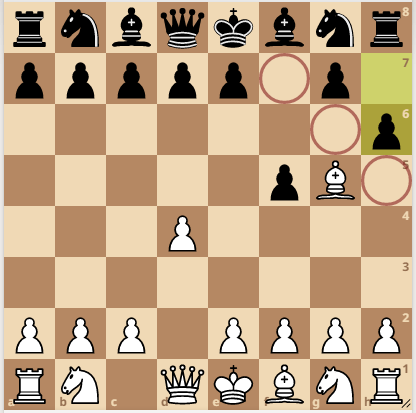
If white could just get his queen from d1 to the h5 square, the black king would be in checkmate. Therefore, white’s strategy is to open the d1 to h5 diagonal for the queen with a timely e4 pawn advance.
Step 3: Retreat your bishop to h4
After black plays pawn to h6, you should retreat your bishop to h4 as black is threatening to capture it with the h6 pawn.
White could have ignored the threat and continue with his plan of getting the Queen to h5 via pawn to e4. However, this fails because after black captures the bishop, black’s h8 rook gains control over the h-file and white can no longer deliver checkmate on h5 with the queen.
Retreat your bishop to h4
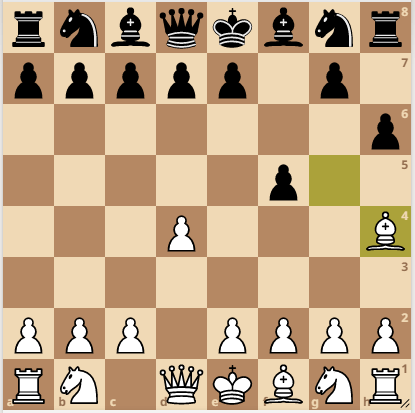
Step 4: Sacrifice Your Bishop With Pawn To e4
If black now plays pawn to 3…g5, you should play pawn to e4 in the center. This opens up the d1 to h5 diagonal for the white queen, and threatens mate in 1 on h5.
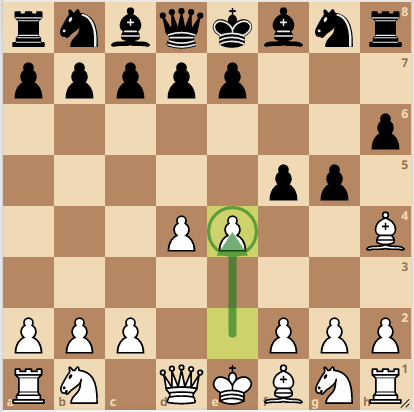
If black gets greedy and capture the bishop on h4, move your queen all the way to the h5 square to deliver checkmate to the black king.

The black king cannot escape from the queen’s blow. His own pieces are blocking his escape route.
The takeway from this checkmate is that you should be careful when pushing pawns around your king as they create weak squares around the king. White was able to exploit these weak squares and win the game in just 5 moves.
3. Staunton Gambit 5 Move Checkmate
The Staunton Gambit is somewhat of a dubious opening where white sacrifices his e pawn as early on move 2. Nonetheless, it comes as a surprise and sets your opponent off guard. Black needs to be armed with some knowledge of opening theory if he should survive some of white’s dubious attacks. The game can end in 5 moves if black is not careful. Read on to find out how.
How to win chess in 5 moves in the Staunton Gambit:
- Move your d pawn 2 squares forward
- Black plays 1…f5
- Move your e pawn 2 squares forward
- Black plays 2…fxe5
- Move your queen all the way to the h5 square
- Black plays 3…g6
- Calmly develop your bishop to e2
- Black plays 4…gxh5
- Deliver checkmate with your bishop by recapturing the pawn on h5.
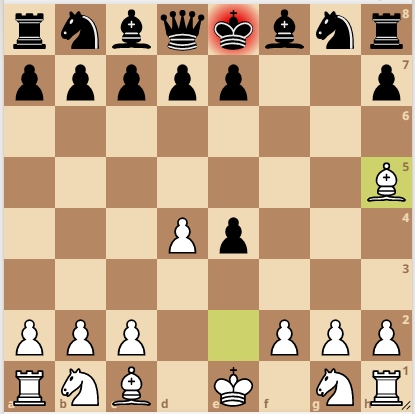
Step 1: Move your d pawn 2 squares forward to d4
First move your pawn to d4. Once again, this move opens up lines for your dark squared bishop on c1 and control the central squares. Black plays pawn to f5 which transposes into the Dutch Defense.
Step 2: Move Your King’s Pawn to e4
Move your king’s pawn to e4. This is known as the Staunton Gambit. At first glance, this move seems dubious and counter-productive.

However, the idea behind sacrificing the king’s pawn is to quickly open up the d1 to h5 diagonal for the white queen.
White wants to give check to the black king and provoke g6 which would weaken the squares around the black king. Still, this move is dubious for white, but the rewards are great if black doesn’t play accurately.
Black plays 2…fxe4 which is the best move.

Step 3: Move your queen to the h5 square to give check to the black king
Move your queen from d1 to h5. Black has no other choice but to play pawn to g6. Black is actually better here, however by playing g6, black weakened the squares around the king.

Step 4: Calmly develop your bishop to e2
Instead of retreating the queen, calmly develop your bishop onto the e2 square. This sets a trap in the position. If black gets greedy and capture the white queen on h5, white will deliver checkmate by playing 5.Bxh5 #
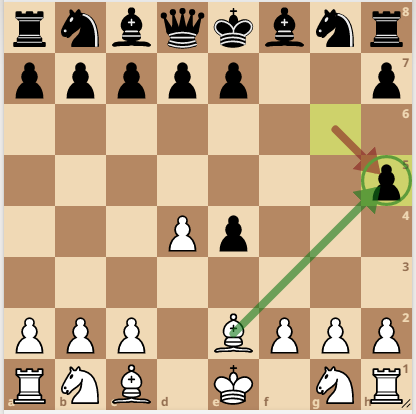
Final Verdict
There you have it, the 3 different ways to winning chess in just 5 moves. If you are tactically aware, you can definitely succeed in checkmating your opponent quickly. Just be mindful of attacking your opponent when you are behind in developent as this can often backfire. These tricks will more likely work on weaker opponents than strong players.


